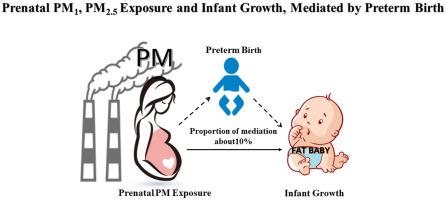Environmental Pollution ( IF 8.9 ) Pub Date : 2021-03-03 , DOI: 10.1016/j.envpol.2021.116792 Shuang Zhou , Lizi Lin , Zheng Bao , Tong Meng , Shanshan Wang , Gongbo Chen , Qin Li , Zheng Liu , Heling Bao , Na Han , Haijun Wang , Yuming Guo

|
Limited studies examined the associations of prenatal exposure to particulate matter (PM) and children’s growth with inconsistent results, and no study focused on PM1. We matched a birth cohort (10,547 children) with daily PM1 and PM2.5 concentrations by maternal home addresses. Air pollution concentrations were predicted by satellite remote sensing data, meteorological factors, and land use information. The weight and length of children in the birth cohort were measured at approximately one year old. We calculated the Z-score of weight for length (WFL) and body mass index (BMI) and then defined overweight and obesity (OWOB) based on WHO Standards. Generalized linear regression and modified Poisson regression were used to identify the association of prenatal exposure to PM1 or PM2.5 with anthropometric measurements and risk of OWOB. We also determined the mediation effect of preterm birth on the associations. Results showed that a 10μg/m3 increase in prenatal exposure to PM1 and PM2.5 was significantly associated with a 0.105 [95% confidence interval (CI): 0.067, 0.144] and 0.063 (95% CI: 0.029, 0.097) increase in WFL Z-score for one-year-old children. Similar associations were found for BMI Z-score. A 10μg/m3 increase in prenatal PM1 and PM2.5 exposure was significantly associated with 1.012 (95%CI: 1.003, 1.021) and 1.010 (95%CI: 1.002, 1.018) times higher risk of OWOB. . Preterm birth mediated 7.5% [direct effect (DE)=0.106, P<0.001; indirect effect (IE)=0.009, P<0.001)] and 9.9% (DE= 0.064, P<0.001; IE=0.007, P<0.001) of the association between prenatal PM1 and PM2.5 exposure and WFL Z-score of the children. The association of prenatal PM1 and PM2.5 exposure with BMI Z-score of children was also mediated by preterm birth by 6.6% (DE=0.111, P<0.001; IE=0.008, P<0.001) and 9.1% (DE= 0.064, P<0.001; IE=0.006, P<0.001). These results remained robust in the sensitivity analyses. In conclusion, prenatal exposure to PM1 and PM2.5 increased WFL, BMI Z-scores and higher risk of OWOB for one-year-old children. The associations were partially mediated by preterm birth. These findings call for the urgent action on air pollution regulation to protect early-life health among children.


























 京公网安备 11010802027423号
京公网安备 11010802027423号